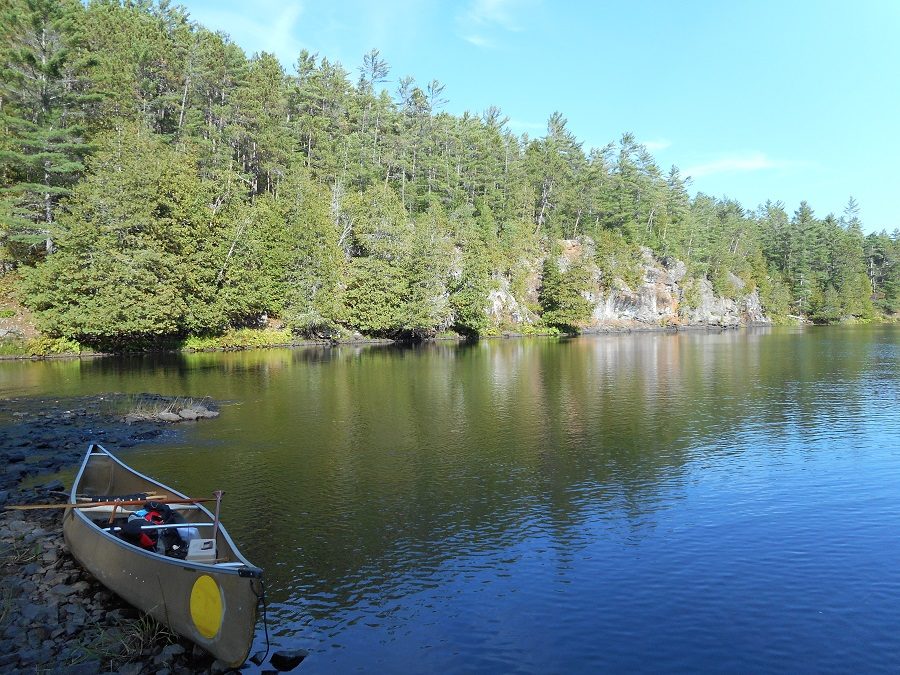This blog comes from David Legros, a Natural Heritage Education Specialist at Algonquin Provincial Park, and lover of backcountry camping.
There you are, standing on the rocky shore of a lake. A windswept pine sits behind you, and a wild landscape before you. Welcome to backcountry camping!
Backcountry camping is perhaps the best way to really experience a wild place. No amenities, very few people, and far from the road, lights, and crowds. It is just you, and the wail of the loon. Sounds great, right?
Well, if you’re new to backcountry camping, this may sound intimidating. After all, the idea of paddling deep into unknown territory, and then carrying everything you brought on your back (including the canoe!) can be scary. You’ll repeat these portages maybe a half a dozen times just to get your campsite.
If this doesn’t sound like your cup of tea, you have options! Many parks that offer backcountry camping have some hidden and not-so-hidden gems out there.
At Algonquin, you can try out backcountry camping without ever having to portage.
To portage or not to portage?

Here are some reasons you may want to try no-portage backcountry camping:
- It is great for people who are new to the activity
- You don’t have to worry about the level of fitness involved in portaging while carrying everything
- You have the psychological comfort of knowing you are not too far into the interior. In case anything goes wrong, you can leave knowing you don’t have a day’s travel ahead of you

- You can introduce young kids to it without going too far, or worrying about bringing too much gear (you don’t have to carry it!)
- You can avoid travelling over or around rapids
- A handy tip: Set up camp on a no-portage site, and use this location as a home base. Then you can explore beyond the next portage for day trips with only the essential gear
Simple spots at Algonquin

All right, so where should you go?
Here we have compiled the no-portage, drive-to backcountry access points. Keep in mind that some of these are pretty remote to start, so consult a map before planning your trip.
A few of these are right along Algonquin’s well-traveled Highway 60 corridor, so amenities such as stores, showers and flush toilets, and visitor centres are more accessible. You won’t have any of this in the backcountry!

Using your Canoe Routes Map, check out the numbered access points, and use this to plan your no-portage trip.
Access Point 3 – Magnetawan Lake, 4 campsites
Access Point 4 – Rain Lake, 14 campsites
Access Point 8 – Cache Lake. There are no campsites on Cache Lake itself, but you can paddle westward on the lake to get to the narrows. From here, you will enter Lake Tanamakoon which has 6 campsites. Located along Highway 60.
Access Point 9 – Rock Lake, 18 campsites. Access south of Highway 60.
Access Point 10 – Spruce Bog Boardwalk. This access point requires a short portage, but it still makes the list because the only portaging you have to do is from your car to the water (~100m). From here, you paddle southwards on Sunday Creek to access Norway Lake (2 sites) and Fork Lake (2 sites). Located along Highway 60.
Access Point 13 – Galeairy Lake. This Algonquin access point is located outside of the park, in the village of Whitney. Paddle west to access the 19 campsites. Motor boats are allowed on Galeairy Lake, so be careful. Located along Highway 60.
Access Point 17 – Shall Lake. A couple of lakes are accessible here: Crotch Lake (11 sites) and Farm Lake (6 sites).
Access Point 20 – Sec Lake, 18 campsites.
Access Point 21 – McManus. At the lower end of the Petawawa, you will find 5 campsites. You may not paddle downstream on this lake, as you will end up in a Canadian Forces Military base.
Access Point 23 – Lake Travers, 21 campsites.
Access Point 27 – Cedar Lake, 26 campsites.
Access Point 29 – Kiosk, 20 campsites.
Preparing for your trip

Now the hard part is to choose where you want to start your trip. Did you know you can now reserve backcountry sites online?
Paddle-in sites let you get to the business of enjoying your trip at the campsite much sooner than portaging well beyond your starting point. Keep in mind that many access points are popular, so you may see quite a few people paddle past you. Also, because they are easy to access there may be competition for sites, so reserve ahead!
No portages means you can bring things that you might not normally bring, like extra or heavy gear, cast iron cook ware, bulky coolers, or a bag of firewood. There are things that you may not bring into the backcountry.
Don’t forget the rules!

Remember that all backcountry rules and regulations apply here, too.
Bottles and cans are not permitted. These create non-burnable garbage and people are less likely to carry them out. This may require a bit more planning when it comes to meal preparations.
Live baitfish for fishing is not permitted. You also must store your food properly to prevent bears and other wildlife from accessing it.

Remember: just because you didn’t portage way out into the interior doesn’t mean you won’t find adventure! Even short trips in the park’s backcountry can ignite your love of nature, and inspire you to keep exploring.
This kind of trip can be like training wheels for someone new to backcountry camping, or a great way to reconnect a camper with an activity they enjoyed in the past.
